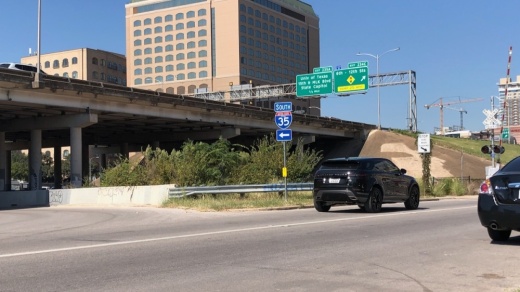TxDOT put forth two proposals in August for the I-35 stretch from Hwy. 290 to Hwy. 71 that would widen the interstate to 20 lanes in some stretches. Opponents of the designs wrote they would add 42 miles of new lanes in a letter to the transportation agency during the public comment period, which ended Sept. 24.
“If you care about traffic, this expansion will add many more hours to an Austinite’s commute. And if you care about the environment, this expansion is game-over for Austin’s climate goals,” reads the letter, signed by RMI Manager Ben Holland; Farm & City Executive Director Jay Blazek Crossley; Reconnect Austin board Chair Heyden Black Walker; and Carter Rubin, mobility and climate advocate at the National Resource Defense Council.
In total, the calculator finds that within five to ten years the 42 additional lane miles would create between 255 million and 382 million additional vehicle miles traveled per year. TxDOT spokesperson Diann Hodges said the agency’s estimate is actually closer to 45 added lane miles but that 32 of those lane miles would be managed.
RMI’s calculator, created in partnership with the University of California Davis, the NRDC and Transportation for America, grounds its methodology in the idea that as lanes are added to the highway, it will induce demand, increasing the number of cars on the road. It cites recent studies that have shown that a 10% increase in roadway capacity leads to an increase in vehicle miles traveled between 6% to 10% within ten years.
“What we've learned from road expansions in lots of different places over many, many years is that there's this relationship that holds up, which is that as you build new lane miles you get somewhere close to proportional increase in [vehicle miles traveled],” RMI associate Lainie Rowland said. “We think that kind of historical understanding should be reflected in planning new transportation projects.”
The tool also uses U.S. Department of Transportation data to customize calculations by looking at the type of vehicles on the road and the size of an area. For example, plugging in 42 added lane miles in the less-populated Beaumont-Port Arthur area yields a 41% lower estimate of the additional gallons of gasoline emissions compared to Austin-Round Rock-Georgetown area.
“If places are already really busy, if the road is already being really heavily utilized, you would expect the impact to be higher because you're increasing starting on a higher base,” Rowland said.
Latent demand
Instead of induced demand, TxDOT sees the potential for “latent demand” with its highway expansion project, Hodges said in an email.
“Traffic conditions on such a highly congested road will involve ‘latent demand.’ This is the travel demand that is unable to use I-35 corridor due to congestion and chooses to use adjacent roads instead,” Hodges said.
Once the expansion is completed, drivers that currently use parallel roads, such as Lamar Boulevard and Congress Avenue, would return to using I-35, she added.
TxDOT is evaluating how each of its two designs, as well as leaving the highway unchanged, would impact aspects of the environment through its environmental impact statement, Hodges said. Some aspects under study include air quality, land use and parkland impacts, and traffic noise with results expected by fall 2022. It also put together a matrix that offered an initial comparison of the impact of the designs on parkland, air quality and hazardous materials.
Austin City Council response
Austin leadership has also raised environmental concerns. Following a TxDOT presentation to the Austin City Council on Aug. 30, District 8 Council Member Paige Ellis referenced the United Nations’ Intergovernmental Panel on Climate Change report in calling for more environmental considerations in the project.
“The IPCC report confirms the evidence is clearer than ever that climate change is making these weather extremes more common and more intense, and it’s unequivocal that human influence is driving these issues,” Ellis said. “It would be irresponsible for us not to be engaging in these conversations around how to make sure that, as the cars do move through the city, we are ensuring there is more connectivity and safety for bikes, pedestrians, wheelchair and stroller users."
TxDOT plans to unveil its preferred design in the fall of 2022, according to its website.





